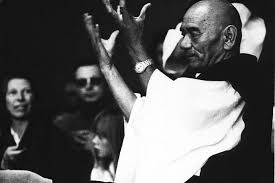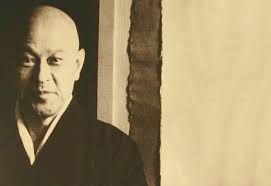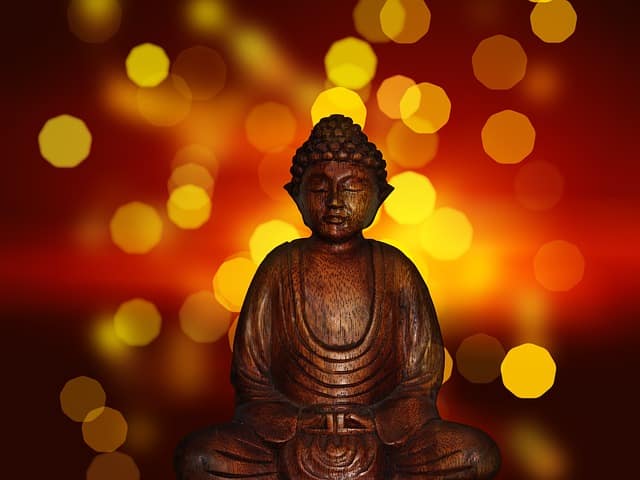Q: What is the most important thing in the martial arts?
T.D. Breathing. What condition are you in below the navel? I don’t mean your sexual organs! I mean the hara, three fingers beneath the navel. The way to develop the power of the hara, to assemble all your energy there, is by right breathing.
Q: Can you talk to us about kiai, the special shout used in the martial arts, especially karate and kendo? In my karate dojo we are made to do it very often, a whole series of violent shouts . . .
T.D. The powerful vibrations of the kiai paralyze the adversary for a brief instant. It is comparable to the kwatz that Rinzai Zen masters use to startle and arouse their disciples. In my opinion there is no point in repeating it over and over, once is enough, but once really. Push out your shout with everything in you, starting from the hara, the lower abdomen or intestines: the place the Japanese also call kikai, the ocean of energy. To do it right you also have to learn Zen breathing, which is the same as in Budo,the long exhalation, as deep as you can. At the very end of it one’s energy is at its greatest. The kiai is that same exhalation, combined with a loud voice; the sound has to spring out naturally from the depths of the body, and for that one obviously has to know how to breathe, which few people do. After zazen, when I conduct a ceremony and we chant the Hannya Haramita Shingyo, the sutra of great wisdom, I do it as a kind of training in breathing; the voice must go to the utter limits of breath. It’s good practice for the kiai. The word kiai is composed of ki, energy, and ai, union, so it means the union of energy. One cry, one instant containing all space-time, the whole cosmos.
Kiai! [At this point Deshimaru Roshi utters a terrifying roar, by which his audience is stunned, then bursts out laughing.]
Q: But the kiai I hear in martial arts dojos, or the Hannya Shingyos chanted in Zen dojos, never have as much power as that! People shout or chant to express their own personalities, they make vocal decoration, there is nothing authentic or really fierce about them. No strength. They’re just singing or making noise. There is no ki in their kiai, no energy. Why not?
T.D. Because they don’t know how to breathe. Nobody has taught them. And then, it takes a very long time to explain the way a true Budo or Zen master would do it. It is not the loudness of the voice that makes the strength of the sound! The sound must start in the hara, not the throat. Observe how a cat meows or a lion roars: that is a real kiai.
Practice breathing; but don’t try to acquire some kind of magic power through your kiai. In the way of Budo as in the way of Zen you must practice, as I am always saying, without any object or desire for profit. Most people always want to get something, they want to have instead of be.Q: Can you talk to us about breathing in the martial arts and in zazen.
T.D. I will try, but it is not easy. Traditionally, the masters never taught it. Breathing does not come until posture is right. To teach you properly, I should have to take my clothes off, but you must understand through your own body. There is a short, natural inhalation at the level of the solar plexus, then a long exhalation, pushing down on the intestines beneath the navel. For one inhalation, the exhalation can last one, two, three, four, even five minutes. When I was young I would dive to the bottom of the swimming pool and stay down two or three minutes. It was as he was breathing out that the Buddha achieved illumination under the bodhi tree. When I read the sutras my breath is very long because I am used to breathing that way. During the exhalation there is a very slight in-and-out motion of air in the nostrils, so one can continue for a very long time. It is extremely difficult and I have been practicing for forty years . . . First you have to understand in your mind, then practice. It is also a very effective means of living a long time; most of the people in the Orient who live to be very old breathe that way. During kin-hin, if I moved at the rate of my own breathing, everybody else would be standing still. These things do have a connection with the martial arts-which are, I repeat, something other than sports. To practice them one must have a strong hara. The martial arts, recitation of the sutras, performance of ceremonies: all of them advance your understanding by training your breathing. When I beat time to the sutras with the clappers, you must go all the way to the end of your breath. It’s good training! Professor Herrigel said much the same in his Art of Archery. He studied that discipline for six years, but only after he had understood how to breathe could he let go of his philosophy and knowledge and hit the target at last. My master used to say, “If he had come to see me, he’d have understood long before!” Judo and karate also train our breathing but most people are unaware of the fact. Only after the 2nd or 3rd dan does this type of breathing begin to take place naturally. Herrigel finally understood unconsciously: the arrow leaves the bow at the end of the exhalation. In judo and karate one is strong breathing out, weak breathing in. You must make your winning move when your partner is breathing in. I can kill a man who is breathing in with a simple object, I do not need a knife. I know that because of an experience I had when I was young; I didn’t actually kill the man in front of me, he only fell down, but . . . Because the end of the inhalation is the point of greatest vulnerability, whereas at the end of the exhalation there is no movement at all. That is why the breathing taught in yoga is of no use in the martial arts. In Japan people do not practice yoga because they have learned Zen breathing. Once you have understood it, it will serve you well in your everyday life. Try it, the next time you grow heated in an argument; it will calm you, you will not lose your self-control. On the other hand, if you receive a shock or blow when you are breathing in, it can paralyze your heart or lungs and actually cause your death. Try lifting a heavy weight twice, once breathing in and once breathing out; you’ll see the difference. You are much stronger when breathing out; your feet grip the earth, you are like a tiger.
If you are ever frightened, or suffering from anguish, or if you feel unsure of yourself in some situation, try the long breath out. It will calm you and give you strength and assurance. It concentrates your energy and awareness.
Q: What is the best way to learn how to breathe properly?
T.D. By sitting zazen. In olden days, in the days of the samurai, meditation was taken seriously: before an action, the men concentrated their faculties through zazen. Concentration first, then action. This still exists today in the abbreviated ceremony that takes place before a match. In zazen you can collect your energy, let your thoughts pass by like clouds, and relax your nervous and muscular tension by concentrating on your posture -straight back, straight neck, hands joined together, thumbs forming a horizontal line, neither mountain nor valley- and by breathing correctly with the emphasis on exhaling deeply into the hara, that area three finger widths beneath the navel.
And then, by zanshin: there is a term you will find in kendo, Japanese fencing. Zanshin is the mind that remains still without being attached to anything, watchful, alert, but unattached. Little by little, this form of alertness is applied to every act of our lives. In Zen, and in traditional Budo as well, the emphasis is on total behavior.
Q: Isn ‘t it possible to replace the zazen posture by intensive training in kata, the basic forms of technique ? They also improve breathing, concentration, alertness…
T.D. You cannot compare the practice of a seated meditation like zazen, a method of concentration, with training in active exercises. But the practice of zazen can add a new dimension to kata.
The essence of kata is not in the gestures themselves but in the attitude adopted toward them; that is what makes them right or not. You must not think, “This kata has to be performed like this or like that.” Instead, you must train the body-mind to create, each time, one total gesture mobilizing the whole ki, in the instant.
***
Taisen Deshimaru: People who do not want to follow the teaching of Zen, the true foundation of Bushido, do not have to do so. They’re simply using the martial arts as playthings; to them they are sports like any others.Many people practice the martial arts, in Europe, the United States, and Japan, without really practicing the way of Budo or the way of Zen. And the general feeling is that the principles and philosophy of Zen have nothing to do with the practice of the martial arts as sports.
But people who want to live their lives on a higher dimension do have to understand. Nobody can be compelled and nobody can be criticized. The first lot are like children playing with toy cars, while the second drive real automobiles. I have nothing against sports; they train the body and develop stamina and endurance. But the spirit of competition and power that presides over them is not good, it reflects a distorted vision of life. The root of the martial arts is not there. The teachers are partly responsible for this state of affairs; they train the body and teach technique, but do nothing for consciousness. As a result their pupils fight to win, like children playing war games. There is no wisdom in this approach and it is no use at all in the business of managing one’s life. What good to them is their technique in everyday life?
Sports are only amusement and in the end, because of the spirit of competition, they wear out the body. That is why the martial arts should strive to recapture their original dimension. In the spirit of Zen and Budo everyday life becomes the contest. There must be awareness at every moment -getting up in the morning, working, eating, going to bed. That is the place for mastery of the self.
Q: Is “championitis” a mental illness?
T.D. Of course. What a narrow vision of life! I don’t mean that one ought never to become a champion; why not? It is an experience like any other. But one must not make an obsession of it. In the martial arts, too, one must be mushotoku, without any goal or desire for profit.
Q: Where do the martial arts come from?
T.D. The art of the sword, lance, bow, or simple fistfighting -they’re almost as old as man himself, because he has always needed to defend himself from attack and to hunt in order to feed himself and his tribe. First, the weapon was discovered -spear, stone hatchet, slingshot, bow- then, gradually, by trial and error, the best possible technique was evolved for each arm. Fighting with their enemies, people learned which blows killed, which wounded, how to parry them, how to counterparry, and so forth. The weapons themselves were perfected, techniques were systematized, and the whole became a part of the art of warfare and the hunt, both of which include other essential elements: knowledge of climate and weather, ability to interpret signs in nature (sounds, tracks, and prints, smells, etc.), understanding of the environment and of the psychology of the adversary (or game, in hunting), intuition of the right movement. A good warrior-hunter must be able to melt into the landscape, become part of it, know it intimately, and respect it. But to return to the Eastern martial arts, the technique of fighting without weapons first became important in the days when itinerant monks were often attacked and robbed, if not killed, by soldiers and brigands -because the monks’ vows forbade the use of weapons. A form of weaponless fighting was initially developed in China, in Bodhidharma’s time, and later split into karate, judo, tai-chi, etc., and by means of these the monks could defend themselves on any occasion. This was the source of the precise and efficient gestures of karate; the subtle judo-holds that utilize the adversary’s own strength; the slow, supple, feline parries of tai-chi: they enabled the monks to take advantage of natural means of defense, adapted in every case to the energy of the individual. In those days the “soft” martial arts were not divided into categories as now, but probably consisted of a collection of movements, blows, feints, and tricks, passed on from one man to the next in the course of their wanderings, just as they also exchanged their potions and recipes – plants, special massages, etc.- or their techniques of meditation (remember that before the Buddha began to practice zazen under his bodhi tree he received instruction from many yogis met on his travels). They also shared the experiences that had taught them something, moral and practical at once, relevant to their lives.
The itinerant monks carried all this knowledge from China toJapan, where, spreading out from the region of Okinawa, it met with spectacular success. Karate and judo became more popular there, while tai-chi remained specifically Chinese.
Q: It is still practiced today in China, every day, on the streets and in factories. I saw a film showing crowds of people performing identical gestures in a sort of fascinating, slow-motion ballet . . .
T.D. Tai-chi used to be only for women and children, old people and the weak. It is a very interesting practice because it teaches the right kind of breathing (as in zazen), together with suppleness of the body and concentration of the mind. It has been called “standing Zen”; but when all is said and done, it is just a dance, a sort of gymnastic without the true spirit of Zen.
french edition: French
Mondo from: The Zen Way to Martial Arts: A Japanese Master Reveals the Secrets of the Samurai by Taisen Deshimaru link
photo credit: cover




